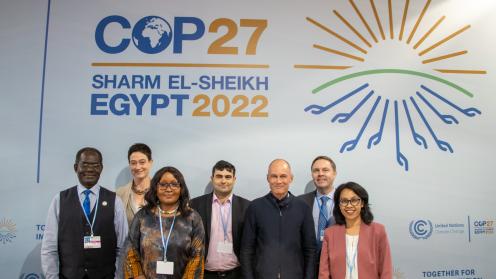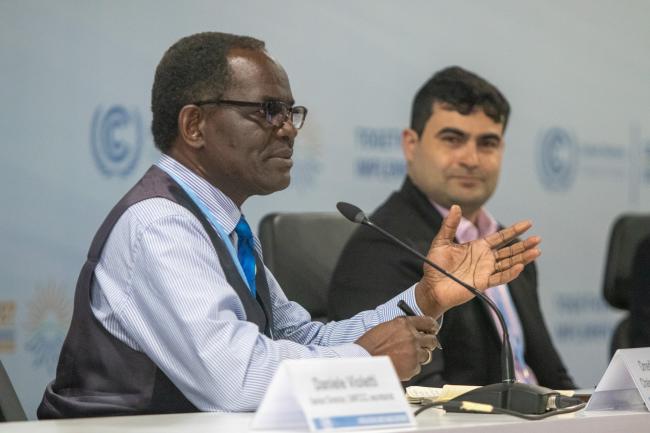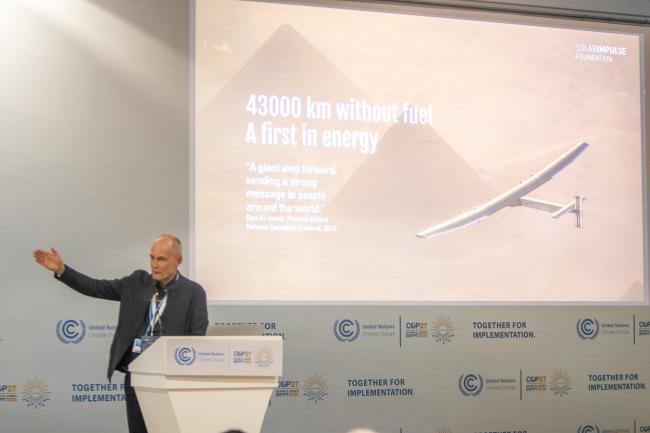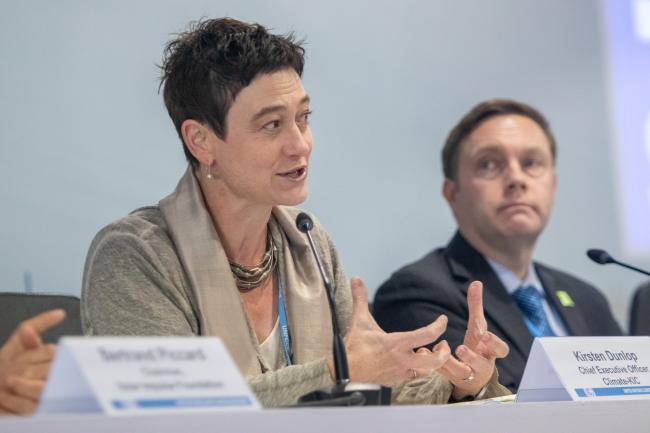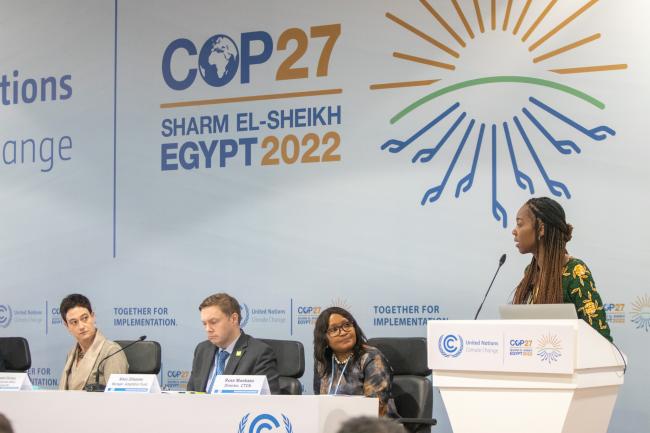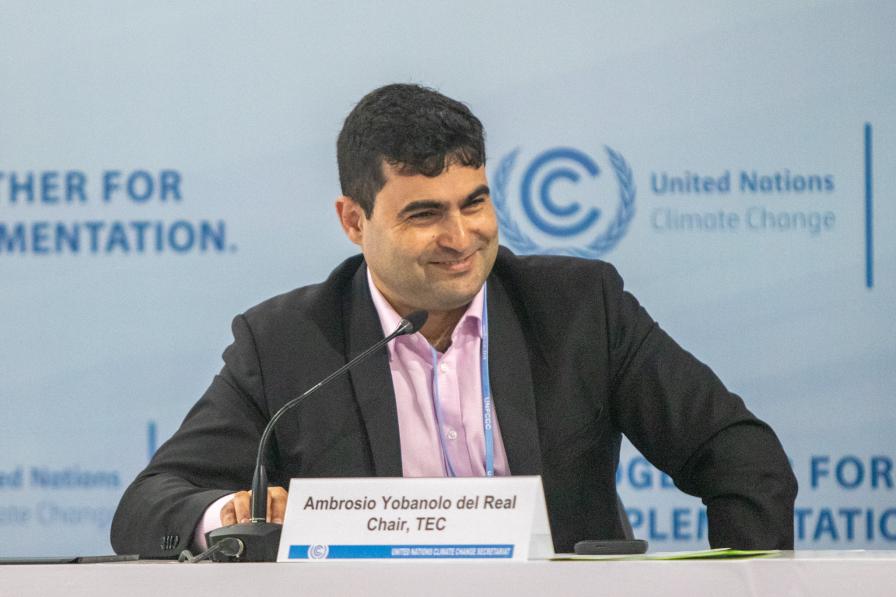About
Technology for effective climate action exists but, according to environmentalist Bertrand Piccard's intervention in a COP 27 side event, it needs to be “pulled” to market: “What we should expect from decision-makers today is to be much more ambitious in legal frameworks, norms, and standards to create a necessity” to use efficient technology.
The Paris Agreement places technology development and diffusion at the heart of responses to climate change. This push to innovate, given increased momentum by the technology framework elaborated at COP 24 in Katowice, is embodied in the first joint work programme of the Technology Mechanism for 2023-2027, which was launched at this event following a dialogue among innovation leaders. The joint work programme cements a long-term collaboration between the TEC and the CTCN to ratchet up the impact of the Technology Mechanism.
Daniele Violetti, UNFCCC Secretariat, opened the event by noting that COP 27 is focusing on implementation, which requires access to the right technology and innovation from all actors. He emphasized that innovation is central to increasing energy efficiency, decarbonizing industry, and enhancing public-private partnerships. He congratulated the Technology Mechanism on the new joint work programme.
Omedi Moses Jura, CTCN, highlighted the network’s collaborative work with developing countries to implement technical assistance. For example, climate innovation labs in Africa, Latin America, and other regions are exploring how to develop and scale up innovative thinking about climate solutions. He invited stakeholders to engage with the network.
Pointing out that the International Panel on Climate Change’s Sixth Assessment Report on mitigation linked innovation and climate goals, Ambrosio Yobanolo del Real, TEC Chair, emphasized TEC’s regular engagement with state and non-state actors to establish national systems of innovation. He emphasized that systemic approaches to strengthening partnerships and engaging stakeholders show “the power of collective action. That is what this event is about.”
In his keynote remarks, Bertrand Piccard, Solar Impulse Foundation, stressed that the technology needed to address climate change and other global problems already exists. Though much focus is placed on pushing energy-efficient technologies to markets through subsidies, incubators, and other initiatives, Piccard emphasized that it is crucial to “pull” these efficient technologies to market through modernized legal and regulatory frameworks. “What we should expect from decision makers today is to be much more ambitious in the legal frameworks, in the norms, in the standards to create a necessity,” he added, in order to use these technologies.
Piccard also emphasized that all too often solving climate change is wrongly viewed as a goal that can only be achieved through measures adverse to economic growth. In reality, he said, climate solutions are profitable. “Each time you hear that solving climate change is a sacrifice, tell them it’s not true,” Piccard urged.
After Piccard’s talk, Rose Mwebaza, CTCN, moderated a panel in which participants and speakers offered their perspectives on the importance and dynamics of innovation.
Kirsten Dunlop, EIT Climate-KIC, highlighted her organization’s work with countries to achieve transformations required to transition to clean energy and sustainable development. She offered examples of “deep demonstrations” that create reinforcing cycles of progress by finding and establishing connections between such things as forests, buildings, carbon sinks, health, and urban planning to create integrated solutions. Such a “portfolio” of solutions creates a “market-building object … It creates precedent. It creates the courage to act. It demonstrates that it is possible.”
Mikko Ollikainen, Adaptation Fund, underscored that climate change adaptation is local, and technological interventions must be tailored to those circumstances. “The technologies being locally appropriate means … that they are adapted to social and economic realities where these approaches take place,” he stressed. This enhances the acceptance of technologies and gives them longer life cycles.
Piccard remembered circumnavigating the globe in the entirely solar-powered Solar Impulse and reflecting on how the world passing below the aircraft was living in the past, still reliant on wasteful technologies and energy systems. He pointed to efficiency as the key element to saving the planet and money that can then be reinvested in innovative and efficient technologies. “The misunderstanding is that we think it is a cost,” he said. He noted these are profitable solutions that just need “clever norms and standards” to bring them to market.
In a question-and-answer period following the panel, audience members noted the need for demonstrations of effective technological interventions and asked how to involve youth, women, and Indigenous Peoples in innovative solutions. Responses included, among other things, solutions require diverse stakeholders, and the need for policy sandboxes that connect concrete, on-the-ground action to decision-makers.
Following this, Jura announced the joint work programme, which “signals a new era of work for an invigorated Technology Mechanism.” Aiming for the transformational changes needed to achieve the goals of the Paris Agreement, the programme will focus on “high-potential sectors and high-potential actions” across water, energy, food, industry, energy, and other systems. “The tools and know-how required to limit warming are available,” he said, adding that “What is needed now is to scale up efforts at a faster pace.” He appealed to all interested stakeholders to engage with the joint work programme.
Organizers: Technology Executive Committee (TEC) and Climate Technology Centre and Network (CTCN), UNFCCC
Contact: Andrea Camponogara I ACamponogara@unfccc.int
For more information: unfccc.int/ttclear/tec
To receive free coverage of global environmental events delivered to your inbox, subscribe to the ENB Update newsletter.
All ENB photos are free to use with attribution. For photos from this side event, please use: Photo by IISD/ENB | Matthew TenBruggencate.
Selected Images

Omedi Moses Jura, CTCN Advisory Board Chair, Kirsten Dunlop, EIT Climate-KIC, Rose Mwebaza, CTCN, Ambrosio Yobanolo del Real, TEC Chair, Bertrand Piccard, Solar Impulse Foundation, Mikko Ollikainen, Adaptation Fund, and Ariesta Ningrum, UNFCCC Secretariat

The opening panel of "Fostering technology innovation to support countries in implementing the Paris Agreement"

Ilke Geleyn, G-STIC, poses a question on including women, girls, Indigenous Peoples and other communities.
